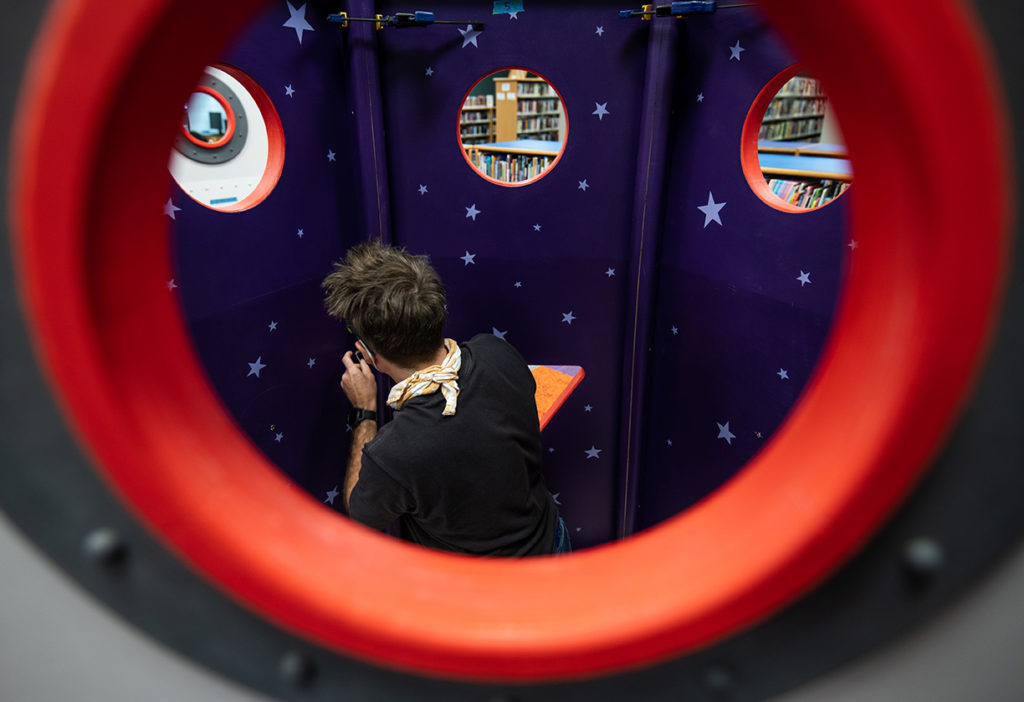A Designer Reimagines the New Children’s Discovery Museum in Waterville
Rusty Lamer, who specializes in creating installations for kids, lends his whimsical designs to the museum’s new location.

A scream-activated selfie machine, an immersive playground melding science and science fiction, a time machine, and a giant bicycle-inspired wind sculpture are some of the designs artist Rusty Lamer has brought to life. In June a rocket reading nook, which he designed and built as a cozy, imaginative space for kids, landed at the Winslow Public Library.
Lamer’s resume is as whimsical as his design projects: formally trained in sculpture and landscape architecture, he’s run the Maine College of Art’s foundry, designed large-scale sculptural installations across the country, managed a farm in Italy, and lived in a restored chicken coop in an olive grove, where he worked at odd jobs from masonry and garden design to wild boar butchering. The Cape Elizabeth native worked designing exhibits for the Chabot Space and Science Center in Oakland, California, before he returned to Maine to start a family five years ago. In 2018 he founded Field Magnet Design, an art and design studio focused on sculptural installations.
Lamer is now collaborating on a landscape project with his mentor, the sculptor Douglas Hollis, for a park in Philadelphia, but his biggest current project is designing the Children’s Discovery Museum of Central Maine, which, after almost 30 years in Augusta, will move to a larger space with a complete redesign in an old church in Waterville.
The Children’s Discovery Museum had been slowly developing ideas for a few years before connecting with Lamer, who stopped by the museum to see if they could use his help. “It was very serendipitous,” says executive director Amarinda Keys. “We were moving into the phase of trying to figure out, how do we get what we have in our heads down, and how do we build it?” Keys says Lamer picked up where they had hit a wall.
For the past three years, Lamer and the museum team have been working on hammering down and smoothing out those initial ideas, which center around the importance of learning through play, discovery through creation, and a sense of connection to the communities and environments of Maine. Slowed by the pandemic, they’ve worked through several different development phases. They’re now wrapping up final designs, refining concepts, and deciding on details like dimensions, color palettes, and materials.
The pandemic not only slowed progress but forced Lamer to change his creative process. “I think three-dimensionally,” he says. “And I like building with my hands.” Lamer makes quick miniature models out of scrap materials to help him think through a design, then builds larger models out of wood in his studio. But, what with homeschooling his son and welcoming a new baby last April, he didn’t often get that opportunity.
“I retreated into my notebooks,” says Lamer. He’s gone through seven notebooks on the project so far, usually sketching at night, working through fragments of ideas that come to him throughout the day or while rocking a child to sleep. Throughout his design process, Lamer has worked with a small team of contractors that shifts depending on the phase, including architects, a graphic designer, a content developer, and, soon, artists and makers who will help him build the exhibit pieces.
Perhaps the most important team member for this project has been Lamer’s five-year-old son, Dash, who guided the creation of key pieces of the exhibits, such as a campfire around which children can make stew and tell stories. There’s also a fishing pond whose design was inspired by little wooden fish and fishing poles Lamer and Dash made, as well as by the play of shadows on their back deck. For a pizza-making corner, the father and son cut out scraps of felt and cardboard circles and made a mock-up of a pizza oven at home. “Dash would be sort of my test subject, and we’d make pizzas, and see where he takes it,” says Lamer.

This process of play and experimentation is how the exhibits came together, and it’s one Lamer felt at home with even before he started designing for children. He says he’s always been able to tap into a child’s mindset, but still joked with his wife that they would need to have children to help him with his work.
“You’re operating in a narrow channel where you don’t want to overdesign or overprescribe, but you don’t want to underdesign so it’s sparse,” he says. “You want just enough where you’re suggesting worlds for kids to occupy, and they can expand upon their own imaginations. Then that world balloons out, and there’s little moments along the way to prompt them or spark their imagination to keep that thread going.”
Exhibit installation at the Children’s Discovery Museum will begin later this summer, and Lamer and Keys hope to invite children back to the museum for a phased opening starting this fall. They’ll collect feedback from kids as they continue to build, with completion of all the exhibits slated for next spring. Keys says she can’t picture creating the museum without Lamer. “He just has a unique skill set a lot of people need, and he’s so thoughtful about every single thing.”
Read more makers stories:
- This Sustainable Clothing Collection Translates Poems into Physical Garments

- World-Class Flake Salt Fresh From the Coast

- Maine’s Favorite Candle

- The Entrepreneur Turning Water Bottle Waste into Sunglasses




